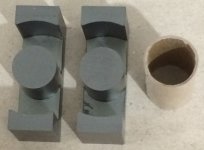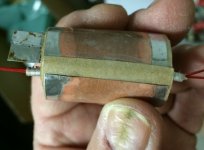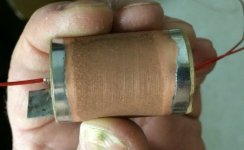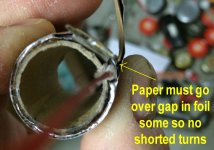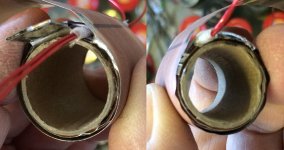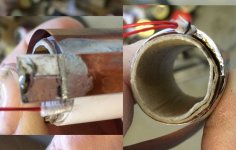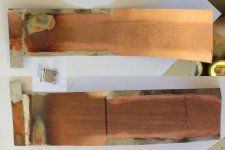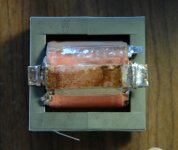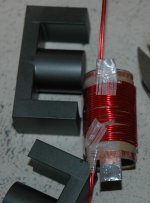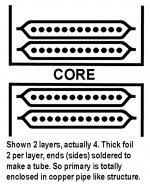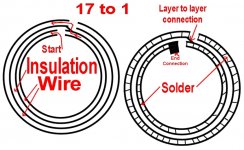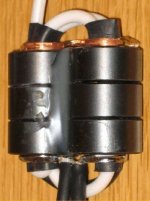Fooey could you give an explanation of "Using ferrite and winding my way is still the best[/B]. Frequency response is probably into the megahertz, and efficiency is very high"
What is "your way"?
Fooey winds an autoformer that I do know and he has been in the electrical game for many years and he believes the there is no other way to build a transformer other than the way he builds them.
Attachments
Ok I see. Yes I make ribbon transformers same way as in your picks. I did not see any advantage in the foil secondary other than it made it easy to get consistent results ( no issue with uneven interleaving of primary and secondary that can happen with multi filliar winds). Also it was an easy way to get a very low secondary resistance wich helps efficiency.
The confusion on my part is in Fooey's post there is mention of response to megahertz. I am thinking he is not talking about his ribbon transformers?? Or is he measuring his transformers response with NO ribbon connected??
The confusion on my part is in Fooey's post there is mention of response to megahertz. I am thinking he is not talking about his ribbon transformers?? Or is he measuring his transformers response with NO ribbon connected??
Ok I see. Yes I make ribbon transformers same way as in your picks. I did not see any advantage in the foil secondary other than it made it easy to get consistent results ( no issue with uneven interleaving of primary and secondary that can happen with multi filliar winds). Also it was an easy way to get a very low secondary resistance wich helps efficiency.
The confusion on my part is in Fooey's post there is mention of response to megahertz. I am thinking he is not talking about his ribbon transformers?? Or is he measuring his transformers response with NO ribbon connected??
I havent made a transformer like this but these are the images of Fooey transformer.
Do you also use a similar core and a autoformer as such?
Fooey will have to answer you on the Megahertz.
Lowmass may you explain this in a of detail?
Also it was an easy way to get a very low secondary resistance wich helps efficiency.
Also it was an easy way to get a very low secondary resistance wich helps efficiency.
I havent made a transformer like this but these are the images of Fooey transformer.
Do you also use a similar core and a autoformer as such?
Fooey will have to answer you on the Megahertz.
I have used the same cores shown in pics. Its a basic ferrite core. I have probably 4-5 different sized ones at the moment. Some with foil secondary's and some with multi filliar secondarys
As well I have a number of other transformers with similar winds that use laminated silicon iron cores and a few that use Amorphous cores.
Lowmass may you explain this in a of detail?
Also it was an easy way to get a very low secondary resistance wich helps efficiency.
Much of the efficiency of the transformer has to do with the resistance of the primary and secondary conductors. Using a foil as a secondary rather than multiple runs of thick wire just makes it easy to get low resistance AND not have to deal with the complications of getting an even distribution(interleaving) of pri and sec wires.
Okay thanks makes sense.
What core do you use in your dyna ribbons if you don't mind me asking?
What core do you use in your dyna ribbons if you don't mind me asking?
Okay thanks makes sense.
What core do you use in your dyna ribbons if you don't mind me asking?
In the end after months of listening tests we chose a laminated silicon iron C core.
Initially we were set on amorphous core under the presupposition that they must be better. We went months in test just using the amorphous. Then one day after much abuse there was a short in one of the amorphous transformers so we switched back to the silicon iron to finish test. Then a week or so later switched back to amorph. What was difficult to accept was that the sil iron core seemed to sound better. Wasnt sure what it was exactly. So that started about a 3 month back and forth war between 3 different cores, sil iron, amorph, and ferrite. This testing was done using 3 different ribbon foil thicknesses ranging from 4, 8,and 12 micron. Both foil only ribbons and laminated foil /plastic constructions.
What was consistently noticed was that initially there was mo measured or listening difference BUT that over time it always seemed that the simple silicon iron core was the easiest to listen to. Really could not put a finger on what it was and couldn't see any difference in freq response, CSD, distortion, But in extended listen it just always seemed that the sil iron core was better.
This is going to fly in the face of all sorts of technical and theoretical beliefs BUT I suspect there is more to overall good sound than just a assembly of technically superior parts.
How it sounds is what counts at the end of the day we sometimes get so involved in measuring and the technical that we can miss a diamond in the rough.
Thanks for sharing that lowmass.
Thanks for sharing that lowmass.
Coils
Here is made up cross section of windings. This idea I got from high power RF amplifiers that used low voltage transistors, so very low impedances. These transformers work good up to 30 MHz, so this one should be good for a few MHz since the same idea. Primary totally enclosed in a tubular structure so very high coupling across the band.
_______________________________________________________
If at first you don't succeed, get a bigger hammer!
Here is made up cross section of windings. This idea I got from high power RF amplifiers that used low voltage transistors, so very low impedances. These transformers work good up to 30 MHz, so this one should be good for a few MHz since the same idea. Primary totally enclosed in a tubular structure so very high coupling across the band.
_______________________________________________________
If at first you don't succeed, get a bigger hammer!
Attachments
Thanks Fooey, very interesting wind.
My own foil sec transformers are similar BUT not exactly the same. On mine I am winding primarys in between each layer of secondary foil BUT I am not soldering the edges together to encapsulate as you are.
I wonder at audio frequency how much the encapsulation is doing??
My own foil sec transformers are similar BUT not exactly the same. On mine I am winding primarys in between each layer of secondary foil BUT I am not soldering the edges together to encapsulate as you are.
I wonder at audio frequency how much the encapsulation is doing??
I would say, the totally enclosed doesn't do much until the frequency is at upper part where stray inductance and not unity coupling of primary to secondary can cause loss. Need really good coupling at the low impedance of ribbon, so enclosing it gets rid of most stray since coupling is very close to perfect. Only resistance loss is left. Tests on them show 8 ohm at 20 watts, 2K to 50K. I have no way to test beyond that, and I can only hear up to 12k anyway. I don't have any reason to make and test any other transformers since these work perfectly. Made 4 of them, and at 70 years old, just don't have the time. Would rather make more amps. It is similar to transmission line one, just 4 of them in series. Could make one like the Balun shown, but sure would take a lot of high Mu toroid's.
In the end after months of listening tests we chose a laminated silicon iron C core.
Initially we were set on amorphous core under the presupposition that they must be better. We went months in test just using the amorphous. Then one day after much abuse there was a short in one of the amorphous transformers so we switched back to the silicon iron to finish test. Then a week or so later switched back to amorph. What was difficult to accept was that the sil iron core seemed to sound better. Wasnt sure what it was exactly. So that started about a 3 month back and forth war between 3 different cores, sil iron, amorph, and ferrite. This testing was done using 3 different ribbon foil thicknesses ranging from 4, 8,and 12 micron. Both foil only ribbons and laminated foil /plastic constructions.
What was consistently noticed was that initially there was mo measured or listening difference BUT that over time it always seemed that the simple silicon iron core was the easiest to listen to. Really could not put a finger on what it was and couldn't see any difference in freq response, CSD, distortion, But in extended listen it just always seemed that the sil iron core was better.
This is going to fly in the face of all sorts of technical and theoretical beliefs BUT I suspect there is more to overall good sound than just a assembly of technically superior parts.
Hi Lowmass,
Can you point me in the right direction with regards to buying the silicone laminated c cores?
Regards
Brian
Iv'e came to the same conclusion, after building and listening to ribbons for 4 years. The best sound came with 6 uM ribbon, 20mm wide and 1000mm length, using a toroidal core, from Velleman:
TOROIDAL TRANSFORMERS – ELECTRONIC COMPONENTS – Velleman – Wholesaler and developer of electronics
The transformer was stripped from its original windings, and rewound with 7 sec. turns, made from copper tape, and 70 prim. turns.
TOROIDAL TRANSFORMERS – ELECTRONIC COMPONENTS – Velleman – Wholesaler and developer of electronics
The transformer was stripped from its original windings, and rewound with 7 sec. turns, made from copper tape, and 70 prim. turns.
Sometimes I think old school simple transformers and amps sound better than all this extremely low distortion stuff.
Hi Lowmass,
Can you point me in the right direction with regards to buying the silicone laminated c cores?
Regards
Brian
try these guys for silicon/ iron transformer cores...
Cores & Transformer Components | Grain Oriented Silicon Steel Cores
If theres a problem with quantities just call them and explain what your doin and they may work with ya on small qty. They have been good to me in the past during prototype work.
Hi Lowmass,
Can you point me in the right direction with regards to buying the silicone laminated c cores?
Regards
Brian
try these guys for silicon/ iron transformer cores...
Cores & Transformer Components | Grain Oriented Silicon Steel Cores
If theres a problem with quantities just call them and explain what your doin and they may work with ya on small qty. They have been good to me in the past during prototype work.
try these guys for silicon/ iron transformer cores...
Cores & Transformer Components | Grain Oriented Silicon Steel Cores
If theres a problem with quantities just call them and explain what your doin and they may work with ya on small qty. They have been good to me in the past during prototype work.
Thanks Lowmass.
BTW ALL...
I have tryed many many different winding configurations/ core types in ribbon transformer building. Including similar to those mentioned in this thred.
Conclusion...
radical winds do next to nothing at audio freq.s on ribbon drivers. I literally have piles of transformers with conventional and all these exotic winds and none of them are really any better than any other so long as they are each done well. AND even when done not so well there is no significant difference.
Beware the hype!!
the driving factor in high frequency extension is largely the following..
1- ribbon diaphragm mass
2- the length and/or the space between the secondary leads running from transformer to ribbon. Keep them short and/or close together
I have tryed many many different winding configurations/ core types in ribbon transformer building. Including similar to those mentioned in this thred.
Conclusion...
radical winds do next to nothing at audio freq.s on ribbon drivers. I literally have piles of transformers with conventional and all these exotic winds and none of them are really any better than any other so long as they are each done well. AND even when done not so well there is no significant difference.
Beware the hype!!
the driving factor in high frequency extension is largely the following..
1- ribbon diaphragm mass
2- the length and/or the space between the secondary leads running from transformer to ribbon. Keep them short and/or close together
- Status
- Not open for further replies.
- Home
- Loudspeakers
- Planars & Exotics
- How to make a good transformer for ribbon tweeter?
